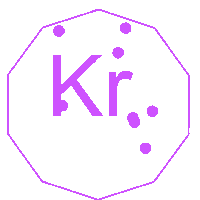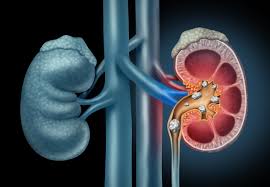Krypton
Noble gases
Atomic mass:83.798 u
Atomic mass:83.798 u
Melting point:-157.36°C (115.79 K)
Boiling point:-153.41°C (119.74 K)
Discovery date:1898

Krypton is a chemical element with the symbol Kr and atomic number 36. It is a member of group 18 (noble gases) on the periodic table. Here’s a detailed overview:
Basic Characteristics
- Atomic Number: 36
- Symbol: Kr
- Atomic Weight: 83.798
- Density: 3.749 g/L at 0°C and 1 atm
- Phase at Room Temperature: Gas
Discovery
- Discovered By: Sir William Ramsay and Morris Travers
- Year of Discovery: 1898
- Method: Fractional distillation of liquefied air
Properties
- Color: Colorless
- State at Room Temperature: Gas
- Melting Point: -157.36°C
- Boiling Point: -153.22°C
Uses and Applications
- Lighting: Used in fluorescent bulbs and as a filling gas in incandescent light bulbs to increase lifespan.
- Photography: Used in high-speed photography flash lamps due to the intense white light it produces when excited.
- Medical: Employed in some medical imaging devices.
- Scientific Research: Used as a reference standard in measuring the isotopic composition of other noble gases due to its stable isotopes.
- Industrial: As a component of gases used for plasma etching in semiconductor manufacturing.
Occurrence
Krypton is quite rare in the Earth’s atmosphere, about 1 part per million by volume. It is obtained commercially by fractional distillation of liquefied air.
Isotopes
Krypton has several isotopes, with Kr-84, Kr-86, Kr-82, and Kr-83 being the most stable and naturally occurring. Kr-85, a radioactive isotope, is used in leak detection and radioactive dating.
Safety
Krypton is non-toxic and inert, presenting minimal chemical reactivity and low biological activity. However, breathing air with a high concentration of krypton instead of normal air can lead to suffocation due to oxygen displacement.
- What is krypton?
- Krypton is a chemical element with the symbol Kr and atomic number 36.
- What type of element is krypton?
- Krypton is a noble gas.
- Where is krypton located on the periodic table?
- Krypton is located in Group 18 of the periodic table.
- Who discovered krypton and when?
- Krypton was discovered by Sir William Ramsay and Morris Travers in 1898.
- How was krypton discovered?
- It was discovered through the fractional distillation of liquefied air.
- What is the atomic weight of krypton?
- The atomic weight of krypton is approximately 83.798 u.
- What is the density of krypton gas at standard conditions?
- The density of krypton gas at standard temperature and pressure is about 3.749 g/L.
- What color does krypton gas emit when electrically excited?
- Krypton gas emits a whitish light when electrically excited.
- Is krypton reactive?
- Krypton is very unreactive due to being a noble gas.
- What are the primary uses of krypton?
- Krypton is used in lighting, such as in high-intensity lamps and fluorescent bulbs, and in some applications in photography and medicine.
- How is krypton typically obtained?
- Krypton is typically obtained through the fractional distillation of liquid air.
- What are some characteristics of krypton’s electron configuration?
- Krypton’s electron configuration is [Ar] 3d10 4s2 4p6.
- What is the boiling point of krypton?
- The boiling point of krypton is -153.22°C.
- What is the melting point of krypton?
- The melting point of krypton is -157.36°C.
- Does krypton form any compounds?
- Krypton forms few compounds, such as krypton difluoride (KrF2).
- Is krypton found in the Earth’s atmosphere?
- Yes, krypton is found in the Earth’s atmosphere at about 1 part per million by volume.
- Can krypton be solidified?
- Yes, krypton can be solidified under extreme cooling and pressure conditions.
- What are some key isotopes of krypton?
- Key isotopes include Kr-84, Kr-86, Kr-82, and the radioactive Kr-85.
- What is a notable application of radioactive krypton-85?
- Krypton-85 is used in leak detection and in industrial gauging applications.
- Is krypton hazardous to human health?
- Krypton is generally non-toxic, but it can act as a simple asphyxiant by displacing air.
- What is the role of krypton in lighting technology?
- Krypton is used in lighting technology to improve the performance and longevity of bulbs.
- How does krypton affect the environment?
- Krypton is inert and has negligible effects on the environment.
- What is the ionization energy of krypton?
- The first ionization energy of krypton is about 14.00 electronvolts.
- How does krypton compare to other noble gases?
- Krypton is heavier than helium and neon but lighter than xenon and radon.
- What scientific research involves krypton?
- Research includes studying the isotopic composition of the atmosphere and its changes.
- What role does krypton play in semiconductor manufacturing?
- Krypton is used in the plasma etching process during semiconductor manufacturing.
- Can krypton be used in medicine?
- Krypton is used in some medical imaging devices for its unique spectral lines.
- What are krypton’s spectral lines used for?
- They are used in various scientific applications, including spectroscopy.
- How pure is commercially available krypton?
- Commercially available krypton is typically very pure, often up to 99.999% pure.
- What happens when krypton becomes ionized?
- Ionized krypton can form ions and is used in ion engines and in some types of lighting.
- Does krypton occur naturally on Earth?
- Yes, krypton is a natural component of the Earth’s atmosphere.
- What is the average concentration of krypton in the atmosphere?
- The concentration of krypton in the atmosphere is about 1 ppm (parts per million).
- How does the cost of krypton compare to other gases?
- Krypton is relatively expensive due to its rarity and the complexity of its extraction.
- What physical form does krypton take at room temperature?
- At room temperature, krypton is a colorless, odorless gas.
- What are the economic implications of krypton usage?
- The economic implications include its use in high-value industries like lighting and semiconductor manufacturing.
- What are the safety protocols for handling krypton?
- Safety protocols include ensuring adequate ventilation to prevent asphyxiation.
- How is krypton stored?
- Krypton is stored in high-pressure gas cylinders.
- What role does krypton play in the laser industry?
- Krypton is used in krypton fluoride lasers for photolithography.
- Can krypton be recycled?
- Krypton can be recycled from industrial processes where it is used as a byproduct.
- What future applications might krypton have?
- Future applications could explore more uses in advanced lighting, medical imaging, and as a potential propellant in space exploration.






